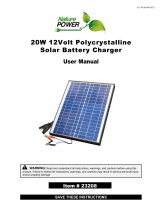
[page 6] | gpelectric.com
GENERAL INFORMATION
2.2 CAUTIONS
Disconnect all power sources
before attempting installation
Electricity can be very dangerous. Installation should be performed only by a
licensed electrician or qualied personnel.
Solar panel safety
Photovoltaic panels generate DC electricity when exposed to sunlight or other
light sources. Contact with the electrically active parts of the panel, such as
terminals, can result in burns, sparks and lethal shock whether the panel is
connected or disconnected.
When panels are connected in parallel, amperages are additive. Consequently,
a system assembled from photovoltaic panels can produce high amperages,
which constitute an increased hazard. Do not touch terminals while panel is
exposed to light. Cover the panel face completely with opaque material to halt
the production of electricity when installing or working with panels or wiring.
Battery and wiring safety
Observe all safety precautions of the battery manufacturer when handling or
working around batteries. When charging, batteries produce hydrogen gas,
which is highly explosive. Work in a well ventilated area and use caution when
making or removing electrical connections. Ensure wires are disconnected
from their power sources when wiring. Do not expose battery to open ame,
cigarettes or sparks. Shield skin and eyes from battery acid.
Ensure all connections are tight and secure. Loose connections may generate
sparks, heat and in extreme cases may catch re. Be sure to check connections
one week after installation to ensure they are still tight.
Work safely
Wear protective eye wear and appropriate clothing during installation. Use
extreme caution when working with electricity and when handling and working
around batteries. Use properly insulated tools only.
Observe correct polarity
at all times
Reverse polarity of the battery terminals will cause the controller to give a
warning tone. Reverse connection of the array will not cause an alarm but
the controller will not function. Failure to correct this fault could damage the
controller.
Do not exceed the voltage
and current ratings of the
Solar Controller
The total current of the solar system is the sum of the short circuit current of
the solar panels in parallel, multiplied by a safety factor of 1.25. The resulting
system current is not to exceed the amperage rating of the controller. The
voltage of the array is the rated open circuit voltage of the solar panels and is
not to exceed 28volts.
The current rating of the solar system is the sum of the Maximum Power Cur-
rent (Imp) of the solar PV strings in parallel. The resulting system Imp current
is not to exceed 30A. If your solar system exceeds these ratings, contact your
dealer for a suitable controller alternative.



























